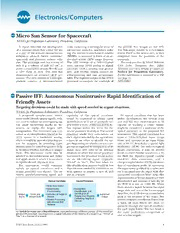
NASA Technical Reports Server (NTRS) 20110016550: Micro Sun Sensor for Spacecraft PDF
Preview NASA Technical Reports Server (NTRS) 20110016550: Micro Sun Sensor for Spacecraft
Electronics/Computers Micro Sun Sensor for Spacecraft NASA’s Jet Propulsion Laboratory, Pasadena, California A report describes the development mask containing a rectangular array of the pinhole Sun images on the APS. of a compact micro Sun sensor for use microscopic pinholes, machined utiliz- The Sun angle, relative to a coordinate as a part of the attitude determination ing the microectromechanical systems system fixed to the sensor unit, is then subsystem aboard future miniature (MEMS), is mounted in front of an ac- computed from the positions of the spacecraft and planetary robotic vehi- tive-pixel sensor (APS) image detector. centroids. cles. The prototype unit has a mass of The APS consists of a 512×512-pixel This work was done by Sohrab Mobasser, only 9 g, a volume of only 4.2 cm3, a array, on-chip 10-bit analog to digital Carl Liebe, Youngsam Bae, Jeffrey power consumption of only 30 mW, and converter (ADC), on-chip bias genera- Schroeder, and Chris Wrigley of Caltech for a 120° field of view. The unit has tion, and on-chip timing control for NASA’s Jet Propulsion Laboratory. demonstrated an accuracy of 1 arc- self-sequencing and easy programma- Further information is contained in a TSP minute. The unit consists of a multiple- bility. The digitized output of the APS is (see page 1) pinhole camera: A micromachined processed to compute the centroids of NPO-30867 Passive IFF: Autonomous Nonintrusive Rapid Identification of Friendly Assets Targeting decisions could be made with speed needed in urgent situations. NASA’s Jet Propulsion Laboratory, Pasadena, California A proposed optoelectronic instru- capability of the optical correlator An optical correlator that has been ment would identify targets rapidly, with- would be exploited to obtain rapid under development for several years out need to radiate an interrogating sig- identification of a set of probable tar- and that has been demonstrated to be nal, apply identifying marks to the gets within a scene of interest and to de- capable of tracking a cruise missile targets, or equip the targets with fine regions within the scene for the might be considered a prototype of the transponders. The instrument was con- neural processor to analyze. The neural optical correlator in the proposed IFF ceived as an identification, friend or foe processor would then concentrate on instrument. This optical correlator fea- (IFF) system in a battlefield setting, each region selected by the optical cor- tures a 512-by-512-pixel input image where it would be part of a targeting sys- relator in an effort to identify the tar- frame and operates at an input frame tem for weapons, by providing rapid get. Depending on whether or not a tar- rate of 60 Hz. It includes a spatial light identification for aimed weapons to help get was recognized by comparison of its modulator (SLM) for video-to-optical in deciding whether and when to trigger image data with data in an internal image conversion, a pair of precise them. The instrument could also be database on which the neural processor lenses to effect Fourier transforms, a fil- adapted to law-enforcement and indus- was trained, the processor would gener- ter SLM for digital-to-optical correla- trial applications in which it is necessary ate an identifying signal (typically, tion-filter data conversion, and a to rapidly identify objects in view. “friend” or “foe”). The time taken for charge-coupled device (CCD) for detec- The instrument would comprise this identification process would be less tion of correlation peaks. In operation, mainly an optical correlator and a than the time needed by a human or ro- the input scene grabbed by a video sen- neural processor (see figure). The in- botic gunner to acquire a view of, and sor is streamed into the input SLM. Pre- herent parallel-processing speed and aim at, a target. computed correlation-filter data files representative of known targets are then Optical Correlator Neural Processor downloaded and sequenced into the fil- ter SLM at a rate of 1,000 Hz. When (cid:127)Wide-Area search there occurs a match between the input (cid:127)Noise/Clutter (cid:127)Recognition, target data and one of the known-target Preprocessing Classification, and Imaged Optics and (cid:127)Detection of Target of Identification of Instrument data files, the CCD detects a correlation Scene Sensor Suite Interest Targets Over Regions Output peak at the location of the target. Dis- Containing Targets of (cid:127)Parallel Processing tortion-invariant correlation filters from Interest with Inherent Shift a bank of such filters are then se- Variance quenced through the optical correlator for each input frame. The net result is An Optical Correlator and a Neural Processor, each performing a different portion of the overall tar- the rapid preliminary recognition of get-identification task, would generate a signal indicative of the identity of a target (e.g., “friend” or one or a few targets. “foe”) in a fraction of a second. NASA Tech Briefs, January 2004 9
